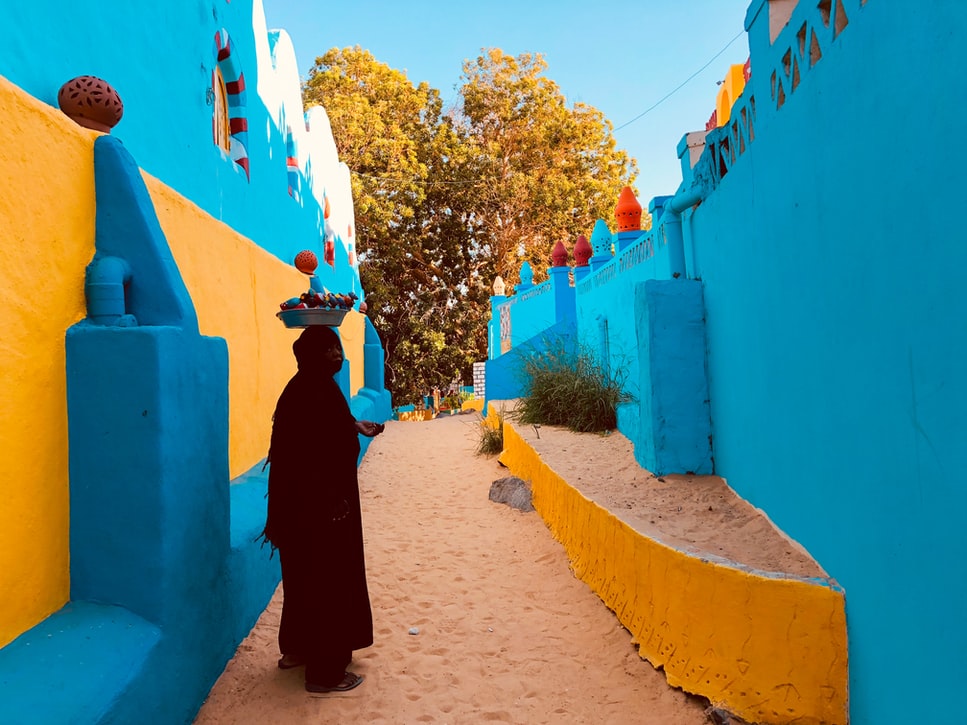Step into a world of vibrant homes, warm hospitality, and ancient traditions that have survived the sands of time. A visit to a Nubian Village near Aswan offers more than a cultural tour—it’s a meaningful connection to one of Africa’s oldest indigenous civilizations.

Historical Background
The Nubians are one of the most ancient ethnic groups in Africa, with roots stretching back to the Kingdom of Kush, a powerful civilization that once rivaled ancient Egypt itself. Historically located in southern Egypt and northern Sudan, Nubians were skilled traders, archers, builders, and spiritualists, with their own distinct language, architecture, and art.
When the Aswan High Dam was built in the 1960s, many Nubian families were displaced as their ancestral lands were flooded by Lake Nasser. In spite of this, they re-established their communities along the Nile, especially near Aswan, where they continue to preserve their language, folklore, and identity with immense pride.
Cultural Significance
Visiting a Nubian village is not like walking through a museum—it’s walking into a living, breathing cultural story. Brightly painted homes with geometric patterns, domed rooftops, and murals of crocodiles and desert life are visual reflections of the Nubian soul.
You'll meet locals who speak Nobiin, share traditional hibiscus tea, and often invite you into their homes to learn about their way of life. Expect to see handmade crafts, natural henna art, and perhaps even a school visit or musical performance.
More than tourism, this is mutual cultural exchange. Visitors support local economies and help keep Nubian heritage alive.
Must-See Attributes
🎨 Vibrant Architecture
-
Homes painted in turquoise, orange, red, and yellow
-
Traditional domes and motifs tell stories of ancestry and faith
🧵 Local Crafts & Markets
-
Handmade jewelry, leather goods, woven baskets, and pottery
-
Ethically sourced and often crafted by women artisans
🐊 Crocodile Houses
Visitor Information
📍 Location & Access:
Accessible by felucca or motorboat from Aswan; located on the west bank or on Elephantine Island
Most tours include boat ride, village walk, tea or lunch
🎟️ Ticket Information:
-
Village entrance is typically free, but support local shops or book a guided tour
-
Felucca ride packages start around $10–$20 USD per person
🕒 Opening Hours:
Daily, best visited between 9:00 AM – 5:00 PM
🗓️ Best Time to Visit:
October to April for pleasant weather; late afternoon for cooler air and golden-hour lighting
Unique Experiences
Photography Tip:
Ask permission before photographing people, especially elders or children. Focus on colorful walls, traditional doors, artisan hands at work, and candid tea moments for the most touching shots.
✅ Quick Facts Box
📍 Location: Near Aswan (various villages along Nile)
🗣️ Language: Nobiin (along with Arabic)
🎨 Known For: Colorful homes, hospitality, and handmade crafts
🐊 Symbol: Crocodile – sacred protector in Nubian folklore
👣 Experience: Personal, warm, family-oriented
Conclusion
A trip to the Nubian Village isn’t just a visit—it’s a homecoming to one of Africa’s most soulful cultures. Walk the painted alleys, sip tea with locals, and listen to stories passed down through generations. It's a side of Egypt that you’ll carry in your heart long after you leave.
Ready to Explore?
Book your Nubian Village Experience with Luxor Booking Tours and discover the heart of Nubia—from its heritage to its people.
Links & Further Reading
✈️ Want more culture? Explore our blog: Live Like a Local in Egypt
🌐 For historical insights: UNESCO Intangible Cultural Heritage – Nubian Traditions
Author’s Note
“Of all the places I’ve guided guests to in Egypt, the Nubian Village always sparks the most joy. It’s colorful, soulful, and deeply human—an experience that feeds both heart and memory.”